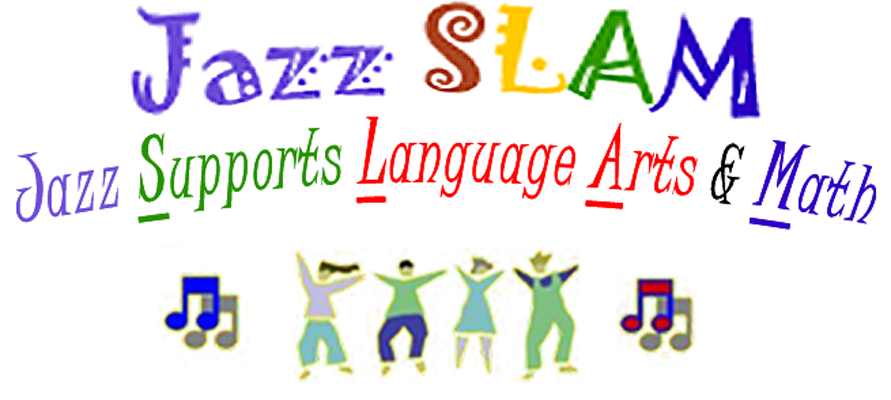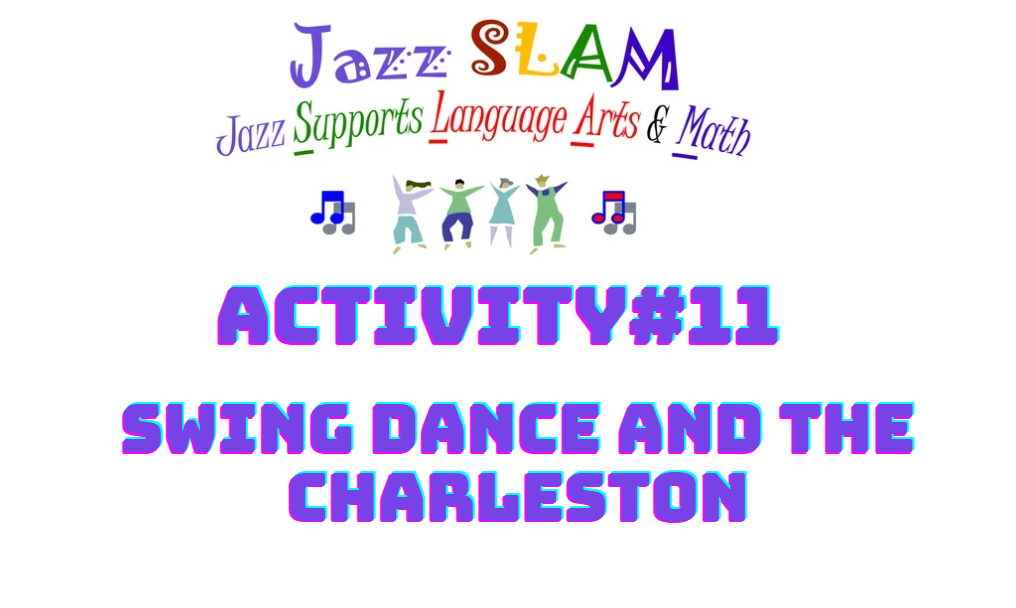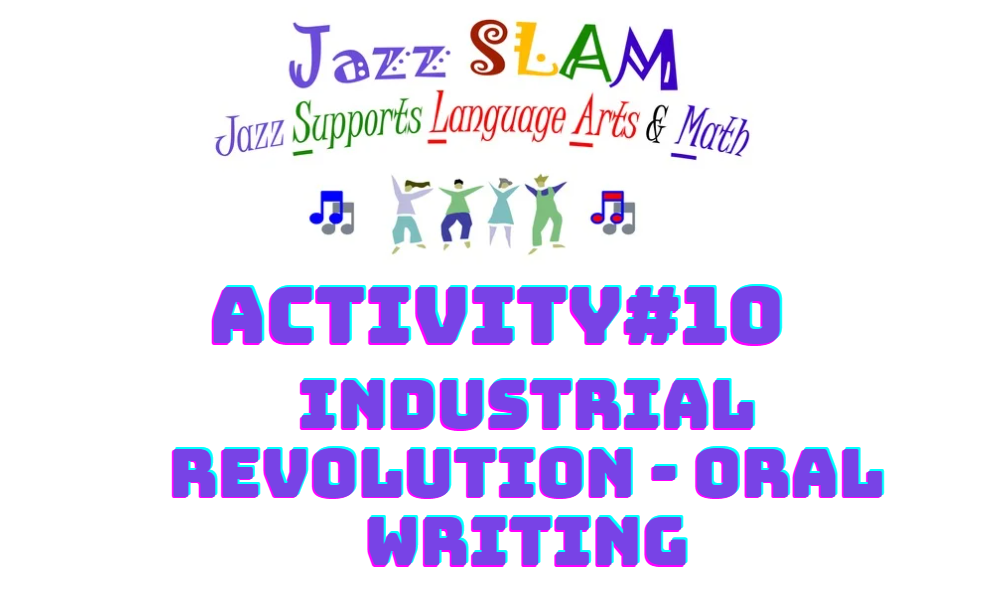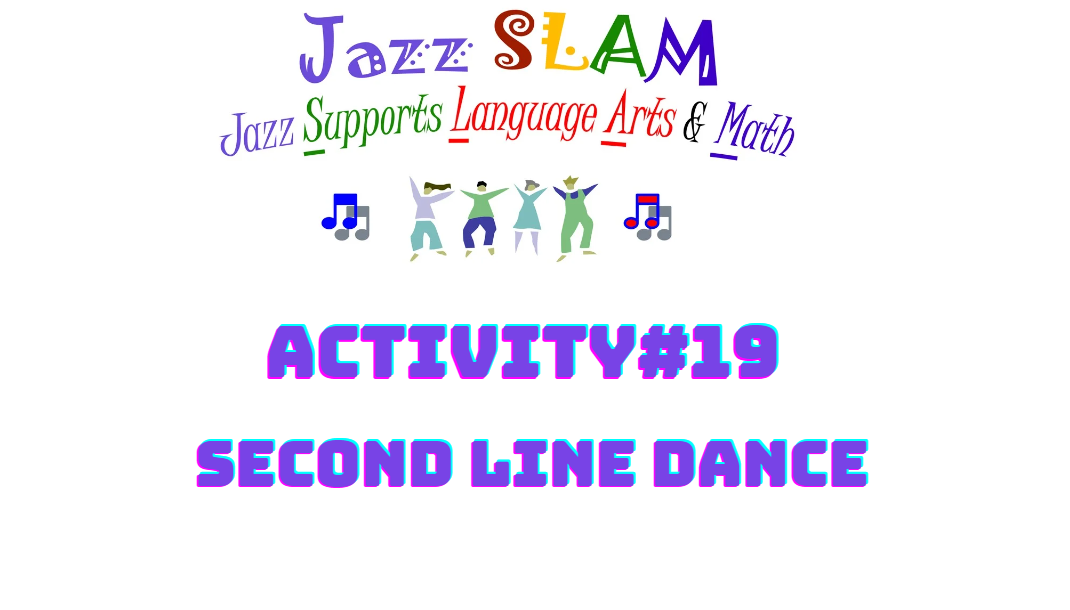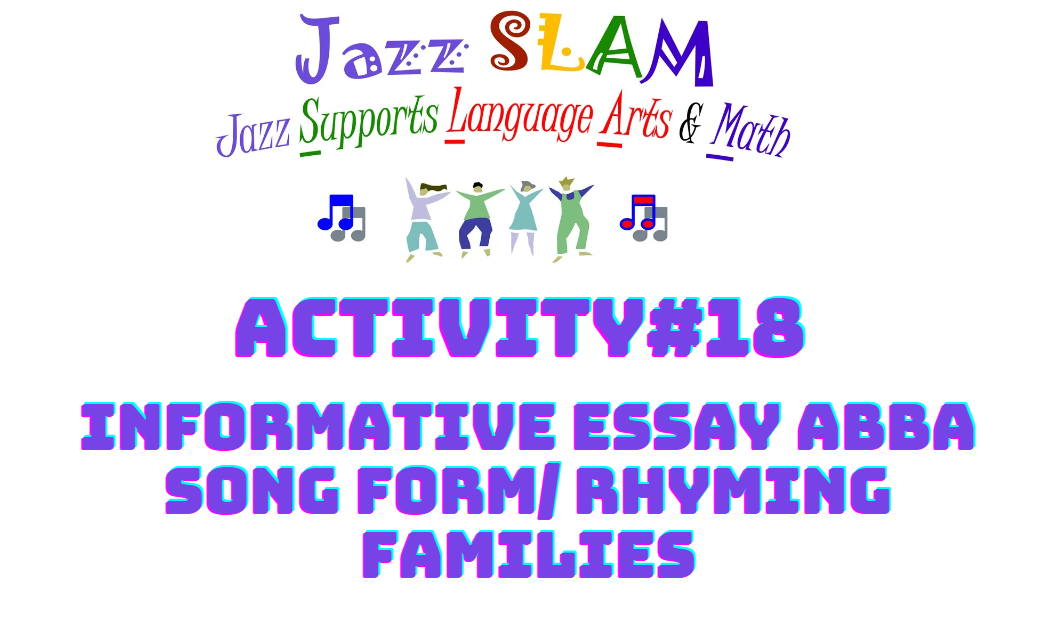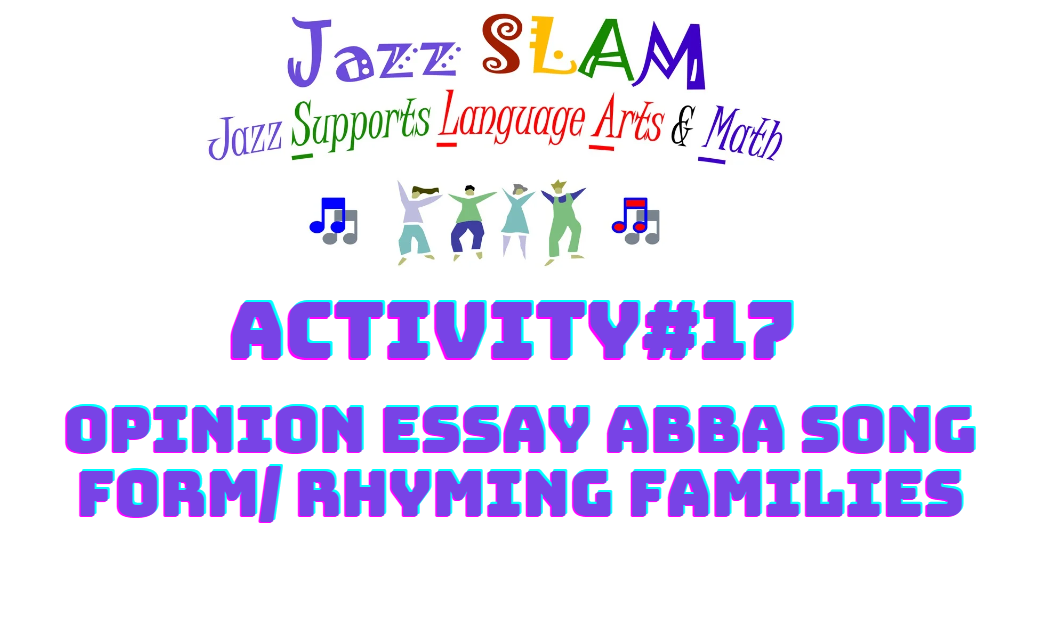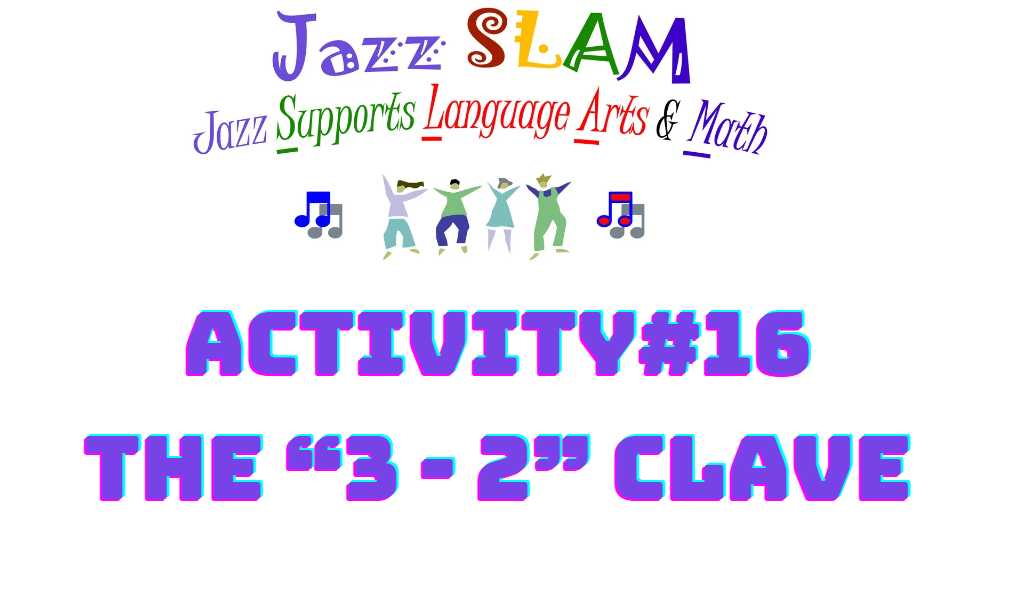About This Lesson
Learning Goals/Objectives
STUDENTS WILL BE ABLE TO:
- Describe the characteristics of “swing”.
- Learn, practice and perform The Charleston
- Understand the importance of the port city of Charleston SC in early American history
Materials/Additional Resources
How to Swing Dance for Beginners
A Very Very Brief history of Swing
Swing History 101: The Birth of Lindy Hop (Early 1900s – 1929)
Denver Airport Swing Dance Flash Mob
Common Core Standards & NGSSS Music Standards
Common Core Standards
RL.3.5 Refer to parts of stories, dramas, and poems when writing or speaking about a text, using terms such as chapter, scene, and stanza; describe how each successive part builds on earlier sections.
RI.3.3 Describe the relationship between a series of historical events, scientific ideas or concepts, or steps in technical procedures in a text, using language that pertains to time, sequence, and cause/effect.
RI.3.7 Use information gained from illustrations (e.g., maps, photographs) and the words in a text to demonstrate understanding of the text (e.g., where, when, why, and how key events occur).
SL.3.1 Engage effectively in a range of collaborative discussions (one-on-one, in groups, and teacher-led) with diverse partners on grade 3 topics and texts, building on others’ ideas and expressing their own clearly.
SL.3.3 Ask and answer questions about information from a speaker, offering appropriate elaboration and detail.
SL.3.4 Report on a topic or text, tell a story, or recount an experience with appropriate facts and relevant, descriptive details, speaking clearly at an understandable pace.
RI.4.5 Describe the overall structure (e.g., chronology, comparison, cause/effect, problem/solution) of events, ideas, concepts, or information in a text or part of a text.
RI.4.7 Interpret information presented visually, orally, or quantitatively (e.g., in charts, graphs, diagrams, time lines, animations, or interactive elements on Web pages) and explain how the information contributes to an understanding of the text in which it appears.
RL.4.5 Explain major differences between poems, drama, and prose, and refer to the structural elements of poems (e.g., verse, rhythm, meter) and drama (e.g., casts of characters, settings, descriptions, dialogue, stage directions) when writing or speaking about a text.
SL.4.2 Paraphrase portions of a text read aloud or information presented in diverse media and formats, including visually, quantitatively, and orally.
W.4.7 Conduct short research projects that build knowledge through investigation of different aspects of a topic.
RI.5.5 Compare and contrast the overall structure (e.g., chronology, comparison, cause/effect, problem/solution) of events, ideas, concepts, or information in two or more texts.
RI.5.7 Draw on information from multiple print or digital sources, demonstrating the ability to locate an answer to a question quickly or to solve a problem efficiently.
RI.5.10 By the end of the year, read and comprehend informational texts, including history/social studies, science, and technical texts, at the high end of the grades 4–5 text complexity band independently and proficiently.
RL.5.5 Explain how a series of chapters, scenes, or stanzas fits together to provide the overall structure of a particular story, drama, or poem.
RI.5.10 By the end of the year, read and comprehend informational texts, including history/social studies, science, and technical texts, at the high end of the grades 4–5 text complexity band independently and proficiently.
SL.5.2 Summarize a written text read aloud or information presented in diverse media and formats, including visually, quantitatively, and orally.
W.5.7 Conduct short research projects that use several sources to build knowledge through investigation of different aspects of a topic.
RI.6.7 Integrate information presented in different media or formats (e.g., visually, quantitatively) as well as in words to develop a coherent understanding of a topic or issue.
SL.6.1 Engage effectively in a range of collaborative discussions (one-on-one, in groups, and teacher-led) with diverse partners on grade 6 topics, texts, and issues, building on others’ ideas and expressing their own clearly.
SL.6.2 Interpret information presented in diverse media and formats (e.g., visually, quantitatively, orally) and explain how it contributes to a topic, text, or issue under study
NGSSS Music Standards
MU.3.C.1.1 Describe listening skills and how they support appreciation of musical works.
MU.3.C.1.2Respond to a musical work in a variety of ways and compare individual interpretations.
MU.3.C.2.1 Evaluate performances of familiar music using teacher-established criteria.
MU.3.H.1.2 Identify significant information about specified composers and one or more of their musical works.
MU.3.O.1.1 Identify, using correct music vocabulary, the elements in a musical work.
MU.3.O.3.1Describe how tempo and dynamics can change the mood or emotion of a piece of music.
MU.3.S.2.1 Identify patterns in songs to aid the development of sequencing and memorization skills.
MU.4.C.1.1 Develop effective listening strategies and describe how they can support appreciation of musical works.
MU.4.C.1.2 Describe, using correct music vocabulary, what is heard in a specific musical work.
MU.4.C.2.1 Identify and describe basic music performance techniques to provide a foundation for critiquing one's self and others.
MU.4.C.2.2 Critique specific techniques in one's own and others performances using teacher established criteria.
MU.4.H.1.2 Describe the influence of selected composers on the musical works and practices or traditions of their time.
MU.4.O.1.1 Compare musical elements in different types of music, using correct music vocabulary, as a foundation for understanding the structural conventions of specific styles.
MU.4.O.3.1 Identify how expressive elements and lyrics affect the mood or emotion of a song.
MU.4.S.2.1 Apply knowledge of musical structure to aid in sequencing and memorization and to internalize details of rehearsal and performance.
MU.5.C.1.1 Discuss and apply listening strategies to support appreciation of musical works.
MU.5.C.1.2 Hypothesize and discuss, using correct music vocabulary, the composer's intent for a specific musical work.
MU.5.C.2.1 Define criteria, using correct music vocabulary, to critique one's own and others performance.
MU.5.C.2.2 Describe changes, using correct music vocabulary, in one's own and/or others performance over time.
MU.5.H.1.2 Compare and describe the compositional characteristics used by two or more composers whose works are studied in class.
MU.5.O.1.1 Analyze, using correct music vocabulary, the use of musical elements in various styles of music as a foundation for understanding the creative process.
MU.5.O.3.1 Examine and explain how expressive elements, when used in a selected musical work, affect personal response.
MU.5.S.2.1 Use expressive elements and knowledge of musical structure to aid in sequencing and memorization and to internalize details of rehearsals and performance.
MU.68.C.1.1 Develop strategies for listening to unfamiliar musical works.
MU.68.C.3.1 Apply specific criteria to evaluate why a musical work is an exemplar in a specific style or genre.
MU.68.H.1.2 Identify the works of representative composers within a specific style or time period.
MU.68.H.1.3 Describe how American music has been influenced by other cultures.
MU.68.H.2.1 Describe the influence of historical events and periods on music composition and performance.
MU.68.O.1.1 Compare performances of a musical work to identify artistic choices made by performers.
MU.68.O.3.1 Describe how the combination of instrumentation and expressive elements in a musical work can convey a specific thought, idea, mood, and/or image.
MU.68.S.2.1 Compose a short musical piece.
ESOL/ESE STRATEGIES
Steps
Step 1:
Watch an instructional swing dance video: How to Swing Dance for Beginners
Step 2:
Watch a fun swing dance video: Denver Airport Swing Dance Flash Mob
Step3:
Listen to and Clap along with The Charleston. It claps just like the word “Charleston”sounds! The Charleston is the basic beat of all swing songs.The Charleston.
Step 4:
Learn& Practice The Charleston dance.
Step 5:
Watch A Very, Very Brief History of Swing (apologiesforvideo quality.)
Step 6:
Learn about the importance of Charleston, as another southern port city. Swing History 101: The Birth of Lindy Hop (Early 1900s – 1929)
Rubric/Instrument for Assessment
4 Points(Advanced):
A score of four is a response in which the student demonstrates a thorough understanding of the concepts and/or procedures embodied in the task. The student has responded correctly to the task, used sound procedures, and provided clear and complete explanations and interpretations.
3 Points(Proficient):
A score of three is a response in which the student demonstrates an understanding of the concepts and/or procedures embodied in the task. The students’ response to the task is essentially correct with the procedures used and the explanations and interpretations provided demonstrating an essential but less than thorough understanding. The response may contain minor flaws that reflect in attentive execution of procedures or indications of some misunderstanding of the underlying concepts and/or procedures.
2 Points(Basic):
A score of two indicates that the student has demonstrated only a partial understanding of the concepts and/or procedures embodied in the task. Although the student may have used the correct approach to obtaining a solution or may have provided a correct solution, the students’ work lacks an essential understanding of the underlying concepts.
1 Point(Emerging):
A score of one indicates that the student has demonstrated a very limited understanding of the concepts and/or procedures embodied in the task. The students’ response is incomplete and exhibits many flaws. Although the students’ response has addressed some of the conditions of the task, the student reached an inadequate conclusion and/or provided reasoning that was faulty or in complete. The response exhibits many flaws or may be incomplete.
0 Points:
A score of zero indicates that the student has provided a completely incorrect or non-interpretable response or no response at all.




